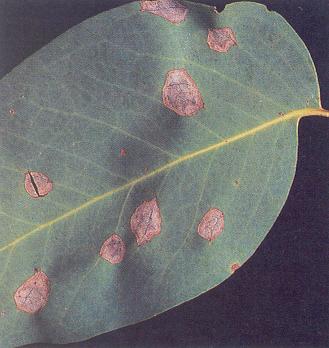PESTS AND DISEASES OF FORESTRY IN NEW ZEALAND
Mycosphaerella leaf-blotch - nursery disease
From Forest Pathology in New Zealand No. 16. Nursery diseases.
Based on Margaret Dick and AL Vanner (1986),
Revised by MA Dick (2008).
Causal organism
Mycosphaerella cryptica (Cooke) Hansford.
Type of injury
Leafspot and shoot dieback.
Diagnostic features
- Reddish brown, irregular-shaped spots with a purple margin on both sides of young leaves. Spots eventually turn dark grey (Fig. 8).
- Holes in leaves.
- Infected leaves often distorted.
- Shoot death.
Hosts
Eucalyptus delegatensis, E. fastigata, E. regnans.
Distribution
All of the North Island south of Whangarei and the northern half of the South Island.
Disease development
Leafspots are circular to irregular in shape, and red- brown with a distinctive purple margin when young, turning dark grey later. Eventually, the dead tissue drops out leaving the leaf riddled with holes. Leaves may become badly distorted and those with extensive infection are readily cast. When the attack occurs on a young shoot, the fungus frequently girdles the shoot causing dieback above that point.
Fruiting bodies of the asexual state of the fungus occur from December to March, and spores are splash-dispersed by water. The sexual state, with its wind- dispersed spores, is present throughout the year. Infection is initiated when spores land on susceptible tissue, germinate, and penetrate the host tissue. Young expanding leaves and shoots are susceptible and infection can occur from spring through to autumn. Optimum temperatures for infection are 18-24oC.
Economic importance
Generally, the disease is of significance only on E. delegatensis seedlings. The disease is usually confined to nurseries where there is an inoculum source nearby, such as a stand of diseased E. delegatensis.
Control
Control can be achieved by fortnightly applications of chlorothalonil e.g. 2l Bravo Weatherstik (500g/l of chlorothalonil), and 0.33 litres of wetting agent in 1000 litres of water per hectare.

Fig. 8 – Leaf lesions on Eucalyptus delegatensis caused by Mycosphaerella cryptica.
Bibliography
Dick, M. 1982: Leaf-inhabiting fungi of eucalypts in New Zealand. New Zealand Journal of Forestry Science 12: 525-537.
Dick, M.; Gadgil, P.D. 1983: Eucalyptus leafspots. New Zealand Forest Service, Forest Research Institute, Forest Pathology in New Zealand No. 1.
Dick, M.A.; Vanner, A.L. 1986: Nursery diseases. New Zealand Forest Service, Forest Research Institute, Forest Pathology in New Zealand No. 16.

 Farm Forestry New Zealand
Farm Forestry New Zealand

